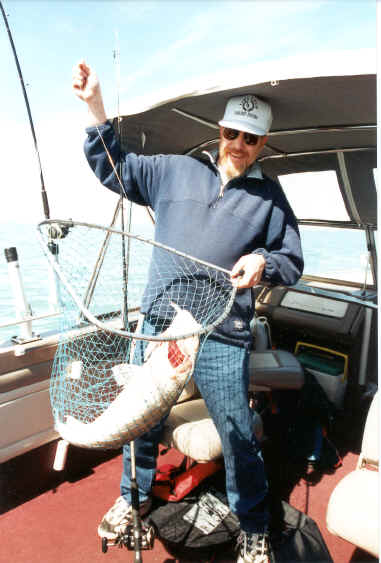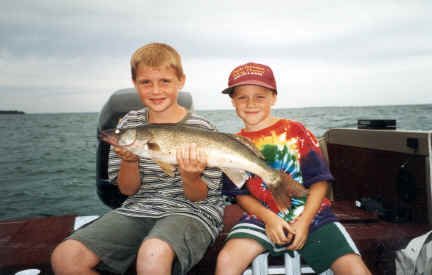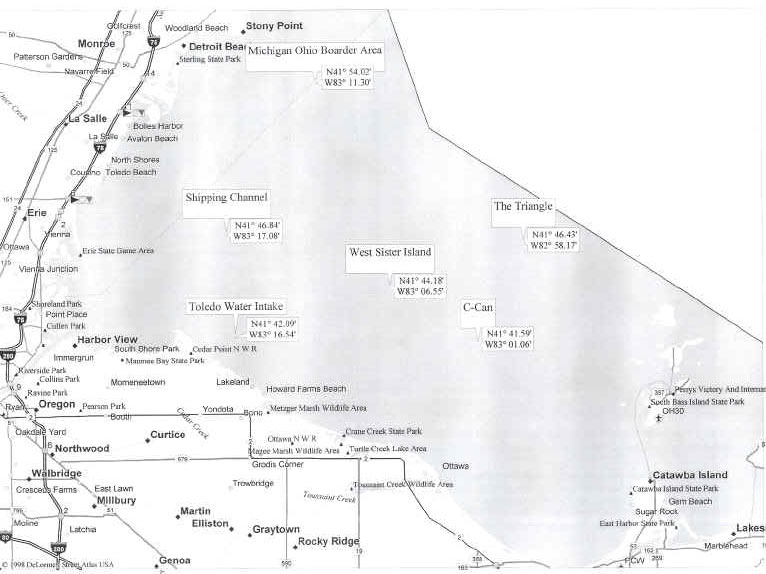
Summer Western Basin Hot Spots
By Michael Veine
It only took my partner and I a short run from Bolles Harbor, MI before fishy
looking marks started showing up on my Lowrance fish finder. We had just hit the
Ohio border about three miles north of the Toledo Harbor Light when I pulled
back on the throttle sending my big Mercury Optimax to a purring idle. At bare
steerage, telltale hooks floated across the screen showing significant marks
close to the bottom. With mirror smooth surface conditions, walleyes often hug
the lake bottom until a chop brings them skyward where they suspend among the
schools of baitfish. During those calm summer mornings, a bottom bouncer
presentation is awfully hard to beat.
We clipped on two-ounce Cabala’s bottom bouncers with trailing spinner crawler rigs. Those rigs consisted primarily of chartreuse colors with some green and orange blade patterns thrown in for good measure. I lowered my bow mounted Minn Kota Auto Pilot electric motor for slow, silent and straight trolling chores. We then free-spooled the rigs down and back until ticking contact with the bottom was obtained. Four of the rigs were spread out using Mr. Walleye boards and it didn’t take long before two of the boards started dropping back signaling a double header. One at a time we retrieved the boards, removed them and then fought the fish to the net. They weren’t big walleyes, but then again they weren’t small either. A steady flow of three pounders poured into the livewell until the wind finally kicked up.
It was like a light switch was flipped off. The wind and resulting chop halted our bottom action forcing us to revamp our tactics. The graph still indicated fish down below, but now they were suspended about 10 feet down. In response we retooled our offerings to a selection of crankbaits and upgraded our propulsion by firing up my 9.9 Mercury four-stroke. We trolled with the wind in a northerly direction until Erie gave up a small walleye to a chartreuse/silver Shad Rap. We switched over a couple of the other baits to the same pattern and within minutes we were pulling in one to two pounders like it was going out of style. After an hour of crankbait trolling, our livewell held a limit of the best eating fish that this author has ever battered and fried.
I’ve always experienced consistent action on Lake Erie during the early summer months of June and July with limit catches being the norm. Fisheries statistics from both Michigan and Ohio also bear this out with early summer producing the most walleyes when compared with all other times of the year.
As Lake Erie’s waters warm up during summer, walleyes respond by moving farther offshore and often lower in the water column. The cooler offshore waters provide that sought after comfort zone that walleyes thrive in. Adult walleyes seem to have an intolerance of warm water and most big fish vamoose during late spring. Smaller walleyes will continue to school up in the Western Basin until the water temperature exceeds the 68-degree mark below the thermocline, which marks a migration towards the deeper and cooler Central Basin. During extremely hot summers, this can occur as early as July: Sometimes the walleyes never leave the Western Basin, except in livewells and coolers of course.
As a licensed captain my operation is called Trophy Specialists Fishing
Charters. As the name implies, I specialize in traveling to fisheries where
prime age class adult sized fish frequently show up in the catch. I consider the
spring walleye fishery on the Western Basin to be the undisputed top destination
for trophy class walleye fishing (I boated 38 walleyes during 2000 that
surpassed 10-pounds). However summer is a different matter all together. Even
though there are more fish in the area during summer, the average size filet
will typically fit easily into a 12" skillet. Even though I don’t run
summer charters in the Western Basin, I often fish for fun targeting those
tasty, eating sized walleyes. In fact I consider Erie’s one to three pound
walleyes to be the best eating fish that’s ever graced my dinner table. They
also freeze well and make up the vast majority of my freezer fish. We also take
enough big fish to keep things interesting.
Since my summer outings are typically launched from Bolles Harbor, I often fish the waters west of the Sister Islands. This area encompasses over 100 square miles of wide-open water. To key in on the fish, some pre-fishing research often pays big dividends. Before leaving home I usually consult various fishing reports on the internet including Lake Erie Walleye Online at www.walleye.com. Before launching I always stop at a bait shop to stock up on both information and fresh crawlers and other sundries. I also prefer afternoon outings because the winds and chop are more conducive to catching walleyes. Afternoon trips also allow me to interrogate returning anglers at the launch further narrowing the search for fish and hot tactics.
During early summer, the waters between the Michigan/Ohio boarder and the shipping channel stretching from the Toledo Harbor Light north to the Canadian border often harbor roving schools of hungry walleyes. Unless I know of a good bite, I usually head out of Bolles towards the Toledo Harbor Light and then veer North/East after hitting 20' water. I won’t start fishing until I mark fish on the graph and I continue the search until pay-dirt is detected. I detest fishing among a pack of boats, so by searching out fish first, I often stumble into hot action away from the crowds.
Later during the summer, I favor the waters between the shipping channel and West Sister Island. This area features waters sliding off to over 25' deep, which tends to hold fish during the dog days of summer. See map
Once I locate a potential fishing area, I let the fish decide what type of presentation they desire. If they’re holding tight to the bottom, then spinner/crawler rigs trailing behind bottom bouncers or a jig and half crawler gets the nod. If the walleyes are suspended, then I always try trolling with crankbaits first. If this assault fails, then I troll using spinner/crawler rigs with Pa’s or snap weights to target those mid-depth fish.
Capt. Rocco Papandrea owns and operates Rock-N-Roll Charters (219-262-3370) out of Port Clinton, OH. An Ohio native, Papandrea has earned a solid reputation as one of the best skippers on the Western Basin and he has also carved out some good success on the PWT, MWT and NAWA tournament trails. Papandrea primarily offers drift fishing charters but will troll up Erie’s ‘eyes at the customers request. Like me, Papandrea stays away from the packs of boats and prefers to find his own fish instead. Using his Pinpoint locator, he skims along until fish are marked. Once found he makes a drifting pass over the fish to determine if they are willing biters. He runs and guns all day searching out active fish and staying with them as they move about.
Papandrea told me, "My favorite June and July hot spots are the shipping channel, West Sister Island, The Triangle, C-Can just north of the firing range and the area out from the Toledo water intake pipe, in that order.
See map on page. My favorite baits for drifting are Parish Peas, Erie Dearies and Lindy’s Flipn’ Harness. We usually drift with a couple ‘draggen rods’ that consist of a crawler harness just off bottom using 2 to 3-oz. inline weights to get them down. At the same time we cast with other offerings to really sift the water.
"For trolling I like to run crawler harnesses behind Pa’s out on the boards. Stinger spoons are also top producers behind Dipsy Divers and cannon balls. I also have good luck trolling with Reef Runner deep Little Rippers in Chartreuse/white finish. My best crawler harness color is purple/chrome with chartreuse and gold also being good colors on any lures."
Summer is the time when limits of walleyes are the norm. Don’t be surprised if the occasional lunker latches onto your bait too. Every year I catch my share of summer time hog walleye, but when it comes to the main ingredient to a delicious fish recipe, I much prefer those eating sized walleyes. Armed with a trusty Fishing Hot Spots Map (800-625-6277) finding those walleye concentrations will be a piece of cake. If you have any questions, [email protected] is my email address.
